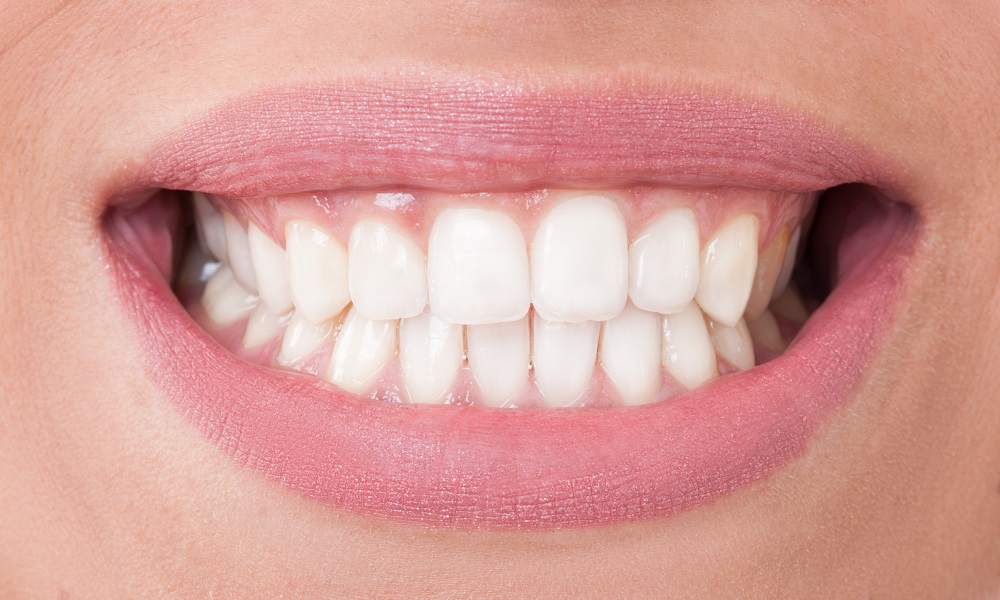Key Takeaways
- Full mouth rehabilitation is a comprehensive dental treatment plan addressing many issues across the entire mouth
- The process uses digital planning to combine crowns, veneers, implants and other restorations
- Treatment duration ranges from 4-12 months depending on complexity
- Common reasons for needing full mouth rehabilitation include bruxism, severe tooth wear, and bite issues
Full mouth rehabilitation restores the smiles of people with widespread tooth wear, several broken restorations, or uncomfortable chewing. It takes a comprehensive approach to restore your teeth’s health, function, and appearance in both the upper and lower jaws.
What Does Full Mouth Rehabilitation Involve?
Full mouth rehabilitation is a customized dental treatment plan that addresses many dental issues across the entire mouth all at once, restoring function, health, and esthetics. Usually, it involves combinations of restorations like crowns and veneers, used alongside digital planning tools for accuracy.
Patients with widespread dental issues from things like tooth grinding, trauma, decay and more usually go this route. Full mouth rehab is restorative and cosmetic, so it improves your smile and the bite/function of your mouth.
Why Would Someone Need Complete Dental Reconstruction?
There are several reasons a person may need full mouth rehabilitation instead of isolated dental treatments:
- Bruxism (teeth grinding): One of the leading causes of enamel loss and dental damage, especially in patients with long-standing habits.
- Severe tooth wear and erosion: This can be due to dietary acids, reflux, or abrasive oral hygiene practices.
- Bite issues or malocclusion: Deep bite or open bite cases often need realignment for functional correction.
- Missing or damaged teeth: These create gaps in function and appearance, requiring comprehensive restoration.
- Trauma or congenital anomalies: Some patients may have had an injury or were born with enamel or tooth formation issues that need correction.
When you have several dental issues at the same time, fixing them one by one doesn’t suffice. Full mouth restoration offers a long-term, functional solution that also restores esthetics.
What Happens During a Full Mouth Evaluation?
Before any treatment begins, your dentist performs a comprehensive evaluation. They’ll conduct several assessments to understand the condition of your bite, soft tissues, teeth, and joints.
This usually includes:
- Medical and dental history review
- Full-mouth X-rays or 3D scans
- Digital impressions and intraoral photography
- Bite analysis and centric relation assessment
- Vertical dimension measurements
- Mockups or wax-ups of planned restorations
- Digital Smile Design (DSD) to preview your new smile
The space between the jaws when teeth are in contact, the virtual dimension of occlusion (VDO), plays a big role. A reduced VDO can impact facial proportions and joint health, so thought and care need to go into restoring it.
What Are the Steps of the Full Mouth Rehabilitation Process?
Every case is different, but most full mouth rehabilitation treatments follow a structured series of steps:
- Initial consultation and diagnosis: Includes imaging, impressions, and treatment planning.
- Mockups and digital smile design: These help patients visualize the results before beginning.
- Bite registration and VDO analysis: Keeps the jaw relationship stable and comfortable.
- Provisional restorations: Temporary crowns or overlays help patients test the proposed function and esthetics.
- Tooth preparation and soft tissue procedures: May include crown lengthening, root canals, or implants as needed.
- Fabrication of final restorations: Using durable materials like zirconia, porcelain-fused-to-metal (PFM), or lithium disilicate.
- Final placement and occlusal adjustment: Ensuring everything functions well together in static and dynamic bite positions.
- Night guard fabrication and long-term follow-up: To protect restorations from bruxism and check stability over time.
There’s a lot of moving parts here, and it may need general dentists, oral surgeons, prosthodontists, and periodontists to all work together.
Which Materials Does Comprehensive Dental Treatment Use?
The right materials have a huge part in how long your results last. Choose materials depending on your bite force, esthetic goals, and oral habits like clenching or grinding.
Here are the most used restorative materials:
- Monolithic zirconia: High strength and ideal for posterior restorations where durability is crucial.
- Lithium disilicate (e.g., E.max): Aesthetic and translucent, best for front teeth or minimally invasive restorations.
- Porcelain-fused-to-metal (PFM): Combines strength with acceptable esthetics, still widely used.
- Resin composite (in limited cases): May be used for transitional or less stressed teeth but is less durable long-term.
Advanced workflows often combine CAD/CAM fabrication for zirconia and digital scanning with conventional techniques for gold or PFM crowns.
How Do Digital Technologies Improve Full Mouth Reconstruction?
These days, dentists have access to digital tools that help them deliver better diagnoses, plans, and full mouth reconstruction results. Tools like intraoral scanning, smile simulation, and CAD/CAM provide accuracy and efficiency.
Benefits of digital dentistry in full mouth rehabilitation include:
- Improved diagnostic accuracy with 3D planning
- Simulated “before and after” visuals via Digital Smile Design
- Faster turnaround on lab work using in-office milling or 3D printing
- Custom-fitted restorations with fewer adjustments
- Enhanced communication between lab and clinician
Digital mockups also make it easier for patients to preview their new smile and take part in decision-making. When the planning process includes patients through DSD and visual simulations, they’re more satisfied with the results.
How Long Does the Full Mouth Rehabilitation Process Take?
The duration varies depending on the patient’s needs and complexity of treatment. On average, full mouth rehabilitation can take 4 to 12 months. Sometimes longer if surgeries or healing phases are required.
Treatment time depends on:
- The number of teeth involved
- Whether implants or periodontal surgeries are required
- The need to track adaptation to new vertical dimension
- Lab turnaround times and patient availability
Patients often wear provisional restorations for several months to test function, esthetics, and joint comfort before the final restorations are delivered.
Is Full Mouth Restoration Painful?
The procedures involved in full mouth rehabilitation usually aren’t painful, thanks to modern anesthetics and gentle techniques. Local anesthesia’s involved in most treatments, and sedation options are available for more invasive steps.
Patients may experience:
- Mild soreness after crown preparation or surgery
- Temporary sensitivity with provisional restorations
- Muscle fatigue when adjusting to a new bite
These side effects are manageable and usually resolve within days. Dentists often prescribe night guards to protect the new restorations and reduce bite strain during sleep.
What Results Can I Expect from Full Mouth Rehabilitation?
Full mouth rehabilitation can improve:
- Chewing efficiency and jaw comfort
- Facial symmetry and vertical height
- Speech clarity and smile esthetics
- Long-term oral function and tooth preservation
When executed properly, the results are both aesthetic and durable. Restorations can last 10 to 20 years or more, especially with good hygiene and night-time protection.
Patients often report improved confidence and reduced jaw or muscle pain post-treatment.
What Does Recovery and Aftercare for Full Mouth Rehabilitation Involve?
Recovery from full mouth rehabilitation is generally progressive and occurs in stages. Following your complete dental reconstruction, you’ll need to follow specific aftercare instructions.
Immediate aftercare usually includes:
- Soft diet for the first 1-2 weeks to allow gums to heal and restorations to settle
- Using prescribed antimicrobial rinses to prevent infection
- Taking any prescribed pain medication or anti-inflammatories as directed
- Avoiding extremely hot or cold foods to prevent sensitivity
Long-term aftercare focuses on:
- Maintaining regular dental checkups every 3-6 months
- Professional cleaning techniques specific to your new restorations
- Periodic occlusal (bite) adjustments as needed
- Replacing your protective night guard every few years as it wears
Most patients achieve full comfort with their new bite within 2-4 weeks. But, minor adjustments may be necessary during the first few months. Your muscles and joints need to adapt to the new occlusion. Your dentist will schedule follow-up appointments to check healing and make any necessary refinements.
Full Mouth Rehabilitation FAQs
Is Full Mouth Rehabilitation the Same as Cosmetic Dentistry?
No. While it improves appearance, full mouth rehabilitation restores function and health as well. Cosmetic dentistry is just about appearance.
Can Full Mouth Rehab Fix TMJ Pain?
Yes, often. Full mouth rehab often reduces joint stress and relieves TMJ symptoms by fixing bite alignment and tooth position.
How do I know if I’m a candidate for full mouth rehabilitation?
You may be a good candidate for full mouth rehabilitation if you have many worn, broken, or missing teeth, experience jaw pain, or find it difficult to chew or speak.
Is Full Mouth Rehabilitation Right for You?
Full mouth rehabilitation is a great step for individuals with widespread dental issues. If you’ve suffered from tooth wear, bite dysfunction, or many failed restorations, a full-mouth approach may be the best path.
Work with a dentist experienced in prosthodontics and digital workflows to assess your needs and design a treatment plan that aligns with your goals and comfort. When carefully planned and precisely executed, full mouth rehabilitation restores quality of life.
Resources:
Dadarwal A, Sharma V, Sareen K, et al. (May 20, 2023) Reclaiming the Smile: Full Mouth Rehabilitation of a Generalized Attrition Patient Using the Hobo Twin-Stage Technique. Cureus 15(5): e39260. doi:10.7759/cureus.39260
Jannati P, Afrashtehfar K, Vakili F, Alikhasi M. Digital Full-mouth Rehabilitation for Complex Cases Involving Severe Deep Overbite and Worn Dentition: A Case Report . Open Dent J, 2023; 17: e187421062309130. http://dx.doi.org/10.2174/0118742106263229230926041533
Lee, Jae-Hyun DMD, PhDa; Kim, Sung-Hun DDS, PhDb,∗; Han, Jung-Suk DDS, PhDb; Yeo, In-Sung Luke DDS, PhDb; Yoon, Hyung-In DDS, PhDb. Contemporary full-mouth rehabilitation using a digital smile design in combination with conventional and computer-aided design/manufacturing restorative materials in a patient with bruxism: A case report. Medicine 98(48):p e18164, November 2019. | DOI: 10.1097/MD.0000000000018164
Yaghoobi N, Mostafavi A, Barati S. Functional and aesthetical full-mouth rehabilitation of a patient with severely worn dentition and deep bite using minimally invasive approach in current vertical dimension: A 3-year follow-up. Clin Case Rep. 2023; 11:e8257. doi:10.1002/ccr3.8257




